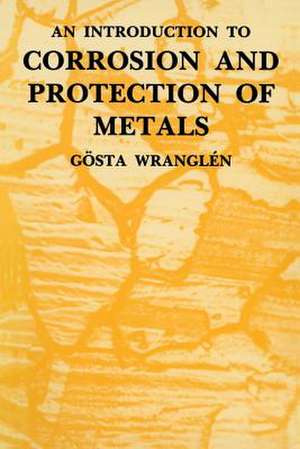An Introduction to Corrosion and Protection of Metals
Autor Gosta Wranglenen Limba Engleză Paperback – 30 mai 1985
Preț: 388.90 lei
Nou
Puncte Express: 583
Preț estimativ în valută:
74.43€ • 76.89$ • 61.94£
74.43€ • 76.89$ • 61.94£
Carte tipărită la comandă
Livrare economică 25 martie-08 aprilie
Preluare comenzi: 021 569.72.76
Specificații
ISBN-13: 9780412260506
ISBN-10: 0412260506
Pagini: 288
Ilustrații: XVI, 288 p. 78 illus.
Dimensiuni: 155 x 235 x 17 mm
Greutate: 0.44 kg
Ediția:1985
Editura: SPRINGER NETHERLANDS
Colecția Springer
Locul publicării:Dordrecht, Netherlands
ISBN-10: 0412260506
Pagini: 288
Ilustrații: XVI, 288 p. 78 illus.
Dimensiuni: 155 x 235 x 17 mm
Greutate: 0.44 kg
Ediția:1985
Editura: SPRINGER NETHERLANDS
Colecția Springer
Locul publicării:Dordrecht, Netherlands
Public țintă
ResearchCuprins
1 Electrochemical elements.- 1.1 Electric conductance.- 1.2 Electrode potentials.- 1.3 Polarization.- 1.4 Potential—distance diagrams and potential—arrow diagrams.- 1.1 Measurement of electrode potentials and polarization.- 1.2 Polarization curves.- 2 Metallurgical elements.- 2.1 Metals and alloys.- 2.2 Carbon and low-alloy steels.- 2.3 Stainless steels.- 2.4 Heat treatment of steels.- 2.5 Slag inclusions in steel.- 2.6 Some important copper and nickel alloys.- 3 Metallic corrosion in various environments.- 3.1 Various methods of systematization of the corrosion field.- 3.2 Systematization of corrosion phenomena according to environment.- 3.3 Corrosion in moist environments, electrochemical mechanism.- 3.4 Corrosion in fused salts and slags, electrochemical mechanism.- 3.5 Corrosion (oxidation) in dry gases (air, smoke gases, steam at high temperature); chemical mechanism.- 3.6 Corrosion in water-free organic liquids and gases; chemical mechanism.- 3.7 Corrosion in molten metals; physical mechanism.- 4 Potential-pH diagrams.- 5 The kinetics of electrochemical corrosion; passivity.- 5.1 Electrode potentials of corroding system: the galvanic series.- 5.2 Mixed potentials: potential—current diagrams.- 5.3 Experimental demonstration of the electrochemical nature of metallic corrosion.- 5.4 Local and general electrochemical corrosion.- 5.5 Passivity.- 6 Hydrogen evolution and oxygen reduction corrosion.- 6.1 Different cathode processes in electrochemical corrosion.- 6.2 Hydrogen evolution corrosion.- 6.3 Oxygen reduction corrosion.- 7 Some important types of electrochemical corrosion.- 7.1 Corrosion cells, acting in electrochemical corrosion.- 7.2 Galvanic macro-cells; galvanic corrosion.- 7.3 Galvanic micro-cells (local cells).- 7.4 Oxygen concentration cells(differential aeration cells).- 7.5 Metal ion concentration cells.- 7.6 Active—passive cells.- 7.7 Electrolytic cells.- 8 Corrosion types, influenced by mechanical factors.- 8.1 Stress corrosion cracking.- 8.2 Hydrogen—induced cracking (HIC) and sulphide stress cracking (SSC).- 8.3 Corrosion fatigue.- 8.4 Erosion corrosion.- 8.5 Cavitation corrosion.- 8.6 Fretting corrosion (frettage).- 9 Atmospheric corrosion.- 10 Corrosion in soil.- 10.1 Soil as a corrosion medium.- 10.2 Comparison between corrosion in soil, air and water.- 10.3 Pitting in soil corrosion.- 10.4 Corrosion of archaeological finds.- 10.5 Corrosion in soil as a method for refining iron.- 10.6 Corrosion problems in the final disposal of spent nuclear fuel rods.- 11 Corrosion in dry gases.- 12 Corrosion protection by change of metal and by design.- 12.1 Change of composition or structure and of stress or surface condition of the metal.- 12.2 Design for corrosion prevention.- 13 Corrosion protection by change in the corrosive medium.- 13.1 Removal of corrosive constituents.- 13.2 Addition of corrosion-retarding substances (inhibitors).- 14 Corrosion protection by change of the electrode potential metal/corrosive medium.- 14.1 Electrochemical (cathodic and anodic) corrosion protection.- 14.2 Cathodic protection.- 14.3 Anodic protection.- 15 Corrosion protection by means of surface coatings.- 15.1 Pretreatment of metal surfaces before the application of surface coatings.- 15.2 Metallic surface coatings.- 15.3 Inorganic, non—metallic coatings.- 15.4 Organic coatings.- 16 Corrosion testing.- 16.1 Different types of corrosion test.- 16.2 Variation of corrosion velocity with time.- 16.3 Characterization of test materials.- 16.4 Control of experimental conditions in laboratory tests.- 16.5 Various methodsfor the evaluation of corrosion tests.- 16.6 Some applications of accelerated laboratory testing.- 17 Potential—pH diagrams for some technically important metals.- General Bibliography.- Appendix: Conversion factors from some American to SI units.

